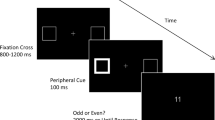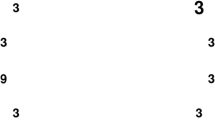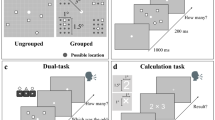Abstract
Healthy individuals are usually biased toward small numbers when they are asked to mentally bisect number intervals or generate number sequences. Number magnitude may be represented spatially along a left-to-right mental number line. The preference for small numbers is believed to reflect the leftward spatial bias of this numerical representation. This study examined whether small numbers captured visual attention more than larger numbers. Participants were asked to detect a target pre-cued by a small or a large number. We found that the response was faster when the target was pre-cued by a small number than when pre-cued by a large number, suggesting that visual attention is preferentially allocated to small numbers. In addition, this attentional preference for small numbers was distinct for participants of different educational backgrounds. For science or engineering participants, this small number preference was enhanced by left-hand responding and was positively correlated with the small number preference in a random number generation task, suggesting that the small number preference was attributable to a leftward bias of the spatial representation. For liberal arts participants, however, left-hand responding did not enhance the small number preference and no correlations were found between the attention task and the random number generation task, suggesting that non-spatial processing mediated the small number preference. Our findings show that the small number preference occurs as early as the perceptual processing stage and distinct mechanisms underlie the preference for small numbers for participants with different educational backgrounds.





Similar content being viewed by others
Notes
Given the spatial representation of numerical information, the small number priority in attracting attention (if any) might be affected by the location of the target. To test this possibility, we conducted ANOVAs with the side of the target as one of the factors for each experiment. The main effect of target side was significant for Experiments 1 and 2 (Exp. 1, F(1, 15) = 11.92, p = 0.004, η 2 = 0.44; Exp. 2, F(1, 28) = 17.18, p < 0.001, η 2 = 0.33). The mean RT was shorter when the target was presented to the left side than when it was presented to the right side. The interaction between the side of the target and the side of the response hand was significant in Experiments 2 and 3 (Exp. 2, F(1, 28) = 65.01, p < 0.001, η 2 = 0.70; Exp. 3, F(1, 70) = 95.54, p < 0.001, η 2 = 0.58). All other interactions involving the target-side factor were not significant.
Subjects of Experiments 1 and 2 were students from an Introductory Psychology course at Zhejiang University. Subjects’ curriculum information of the first two experiments is not available. However, the course was mainly given for students in the College of Science, who were majoring in scientific fields. Thus, the pattern of results in Experiment 2 would likely be similar to that of the science or engineering group in Experiment 3.
References
Bachmann V, Fischer MH, Landolt HP, Brugger P (2010) Asymmetric prefrontal cortex functions predict asymmetries in number space. Brain Cogn 74:306–311
Boland PJ, Hutchinson K (2000) Student selection of random digits. J R Stat Soc Ser D Stat 49:519–529
Bowers D, Heilman KM (1980) Pseudoneglect: effects of hemispace on a tactile line bisection task. Neuropsychologia 18:491–498
Brainard DH (1997) The psychophysics toolbox. Spat Vis 10:433–436
Chapman CS, Gallivan JP, Wood DK, Milne JL, Ansari D, Culham JC, Goodale MA (2014) Counting on the motor system: rapid action planning reveals the format- and magnitude-dependent extraction of numerical quantity. J Vision 14:30
Christie J (2006) Familiarity seekers are fast and novelty seekers are slow. Quart J Exp Psychol 59:312–325
Christie J, Klein R (1995) Familiarity and attention: does what we know affect what we notice? Mem Cogn 23:547–550
Dehaene S (1997) The number sense: how the mind creates mathematics. Oxford University Press, New York
Dehaene S, Mehler J (1992) Cross-linguistic regularities in the frequency of number words. Cognition 43:1–29
Dehaene S, Bossini S, Giraux P (1993) The mental representation of parity and number magnitude. J Exp Psychol Gen 122:371–396
Diedrichsen J, Ivry RB, Cohen A, Danziger S (2000) Asymmetries in a unilateral flanker task depend on the direction of the response: the role of attentional shift and perceptual grouping. J Exp Psychol Human Percept Perform 26:113–126
Eimer M, Forster B, Van Velzen J, Prabhu G (2005) Covert manual response preparation triggers attentional shifts: ERP evidence for the premotor theory of attention. Neuropsychologia 43:957–966
Feigenson L, Dehaene S, Spelke E (2004) Core systems of number. Trend Cogn Neurosci 8:307–314
Fischer MH, Castel AD, Dodd MD, Pratt J (2003) Perceiving numbers causes spatial shifts of attention. Nat Neurosci 6:555–556
Gallivan JP, Chapman CS, Wood DK, Milne JL, Ansari D, Culham JC, Goodale MA (2011) One to four, and nothing more: nonconscious parallel individuation of objects during action planning. Psychol Sci 22:803–811
Göbel SM, Calabria M, Farne A, Rossetti Y (2006) Parietal rTMS distorts the mental number line: simulating ‘spatial’ neglect in healthy subjects. Neuropsychologia 44:860–868
Grade S, Lefevre N, Pesenti M (2013) Influence of gaze observation on random number generation. Exp Psychol 60:122–130
Hartmann M, Grabherr L, Mast FW (2012) Moving along the mental number line: interactions between whole-body motion and numerical cognition. J Exp Psychol Human Percept Perform 38:1416–1427
Hommel B, Schneider WX (2002) Visual attention and manual response selection: distinct mechanisms operating on the same codes. Visual Cogn 9:392–420
Hubbard EM, Piazza M, Pinel P, Dehaene S (2005) Interactions between number and space in parietal cortex. Nat Rev Neurosci 6:435–448
Jewell G, McCourt ME (2000) Pseudoneglect: a review and meta-analysis of performance factors in line bisection tasks. Neuropsychologia 38:93–110
Loetscher T, Brugger P (2007) Exploring number space by random digit generation. Exp Brain Res 180:655–665
Loetscher T, Schwarz U, Schubiger M, Brugger P (2008) Head turns bias the brain’s internal random generator. Curr Biol 18:R60–R62
Loftus AM, Nicholls MER, Mattingley JB, Bradshaw JL (2008) Left to right: representational biases for numbers and the effect of visuomotor adaptation. Cognition 107:1048–1058
Loftus AM, Nicholls MER, Mattingley JB, Chapman HL, Bradshaw JL (2009) Pseudoneglect for the bisection of mental number lines. Quart J Exp Psychol 62:925–945
Longo MR, Lourenco SF (2007) Spatial attention and the mental number line: evidence for characteristic biases and compression. Neuropsychologia 45:1400–1407
Longo MR, Lourenco SF, Francisco A (2012) Approaching stimuli bias attention in numerical space. Acta Psychol 140:129–132
McCourt ME, Jewell G (1999) Visuospatial attention in line bisection: stimulus modulation of pseudoneglect. Neuropsychologia 37:843–855
Moyer R, Landauer T (1967) Time required for judgements of numerical inequality. Nature 215:1519–1520
Nicholls MER, Lew M, Loetscher T, Yates MJ (2011) The importance of response type to the relationship between temporal order and numerical magnitude. Atten Percept Psychophys 73:1604–1613
Pelli DG (1997) The VideoToolbox software for visual psychophysics: transforming numbers into movies. Spat Vis 10:437–442
Posner MI (1980) Orienting of attention. Quart J Exp Psychol 32:3–25
Priftis K, Zorzi M, Meneghello F, Marenzi R, Umilta C (2006) Explicit versus implicit processing of representational space in neglect: dissociations in accessing the mental number line. J Cogn Neurosci 18:680–688
Rath GJ (1966) Randomization by humans. Am J Psychol 79:97–103
Revkin SK, Piazza M, Izard V, Cohen L, Dehaene S (2008) Does subitizing reflect numerical estimation? Psychol Sci 19:607–614
Schwarz W, Eiselt AK (2009) The perception of temporal order along the mental number line. J Exp Psychol Human Percept Perform 35:989–1004
Song JH, Nakayama K (2008) Numeric comparison in a visually-guided manual reaching task. Cognition 106:994–1003
Umilta C, Priftis K, Zorzi M (2009) The spatial representation of numbers: evidence from neglect and pseudoneglect. Exp Brain Res 192:561–569
Wood G, Willmes K, Nuerk HC, Fischer MC (2008) On the cognitive link between space and number: a meta-analysis of the SNARC effect. Psychol Sci Quart 50:489–525
Zorzi M, Priftis K, Umilta C (2002) Brain damage—neglect disrupts the mental number line. Nature 417:138–139
Zorzi M, Priftis K, Meneghello F, Marenzi R, Umilta C (2006) The spatial representation of numerical and non-numerical sequences: evidence from neglect. Neuropsychologia 44:1061–1067
Acknowledgments
This work was supported by the Natural Science Foundations of China (31100731), Zhejiang Provincial Natural Science Foundation of China (LY13C090001), Zhejiang Province Education Department (Y201122208), and the Fundamental Research Funds for the Central Universities. We thank Dr. Shena Lu for correcting the English in the manuscript.
Conflict of interest
The authors declare that they have no conflict of interest.
Author information
Authors and Affiliations
Corresponding author
Rights and permissions
About this article
Cite this article
Cai, YC., Li, SX. Small number preference in guiding attention. Exp Brain Res 233, 539–550 (2015). https://doi.org/10.1007/s00221-014-4134-3
Received:
Accepted:
Published:
Issue Date:
DOI: https://doi.org/10.1007/s00221-014-4134-3




